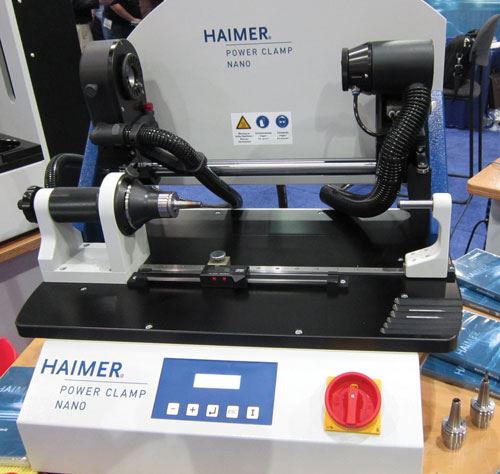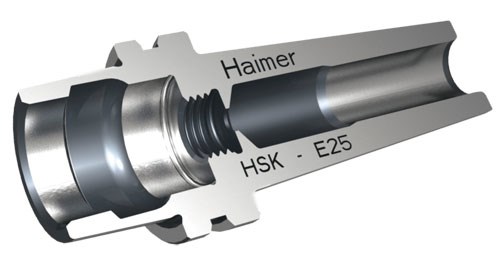Micromachining is being increasingly applied in the electronics, medical and mold making industries. This approach to machining is characterized by very high spindle speeds and low cutting forces to minimize the risk of tool breakage. Toolholders with HSK interfaces are the best option for micromachining applications, says Brendt Holden, president of
Haimer-USA in Villa Park, Illinois. That’s primarily because the toolholder’s hollow-shank design enables its taper to maintain full contact with the spindle as the spindle expands, while a consistent Z-axis tool length is maintained via the face contact provided by the tool holder.
Mr. Holden says a slim, short design makes Haimer’s HSK–E25 series of toolholders well-suited for such applications. The shrink-fit version provides runout of less than 0.003 mm. To speed and simplify cutter changes using these types of toolholders (as well as HSK-50 and BT/SK-30 versions commonly used in micromachining), the company has developed the Power Clamp Nano, a shrink-fit machine that supports solid carbide and HSS tools in diameters ranging from 3 to 16 mm.
Horizontal orientation is a distinguishing design element of this compact new shrink-fit machine. The company found that it is easier to insert and remove small-diameter tools horizontally rather than vertically, because it can be difficult to access tiny tools using vertical shrink-fit machines. The heating coil used in the Power Clamp Nano was developed specifically for micro-shrink-fit toolholders, too, with their characteristic slim profiles and small nose diameters. With typical inductive coils, there is a considerable distance from the inside of the coil to the outside nose diameter of a small toolholder. Consequently, efficiently opening the bore of the toolholder without damaging it by overheating requires accessories. In addition, conventional inductive coils aren’t well-suited for use with non-magnetic, stainless steel toolholders. However, the Power Clamp Nano’s appropriately sized 13-kW coil can effectively heat standard small toolholders as well as stainless steel versions without the need for additional accessories and without damaging the toolholders. Complete heating takes 2 seconds, while the machine’s air-cooling unit cools the toolholder in less than 1 minute.
Other notable features include ±0.01-mm Z-axis tool length presetting as well as a positioning rod that simplifies tool changes. When swapping identical tools, users can insert the rod through the rear of the toolholder until it contacts the back of the old tool. After the tool is extracted, the new tool is inserted until it contacts the rod at the appropriate depth inside the toolholder’s bore. The rod can also be used to eject a tool that might have broken off inside the toolholder’s bore.
Related Content
-
This new quick-change tooling system enables shops to get more production from their Swiss turning centers through reduced tool setup time and matches the performance of a solid tool.
-
To cut out laborious manual processes like hand-grinding, this briquette manufacturer revamped its machining and cutting tool arsenal for faster production.
-
Pairing a shoulder mill with a five-axis machine has cut costs and cycle times for one of TTI Machine’s parts, enabling it to support a niche racing community.



























.png;maxWidth=300;quality=90)
